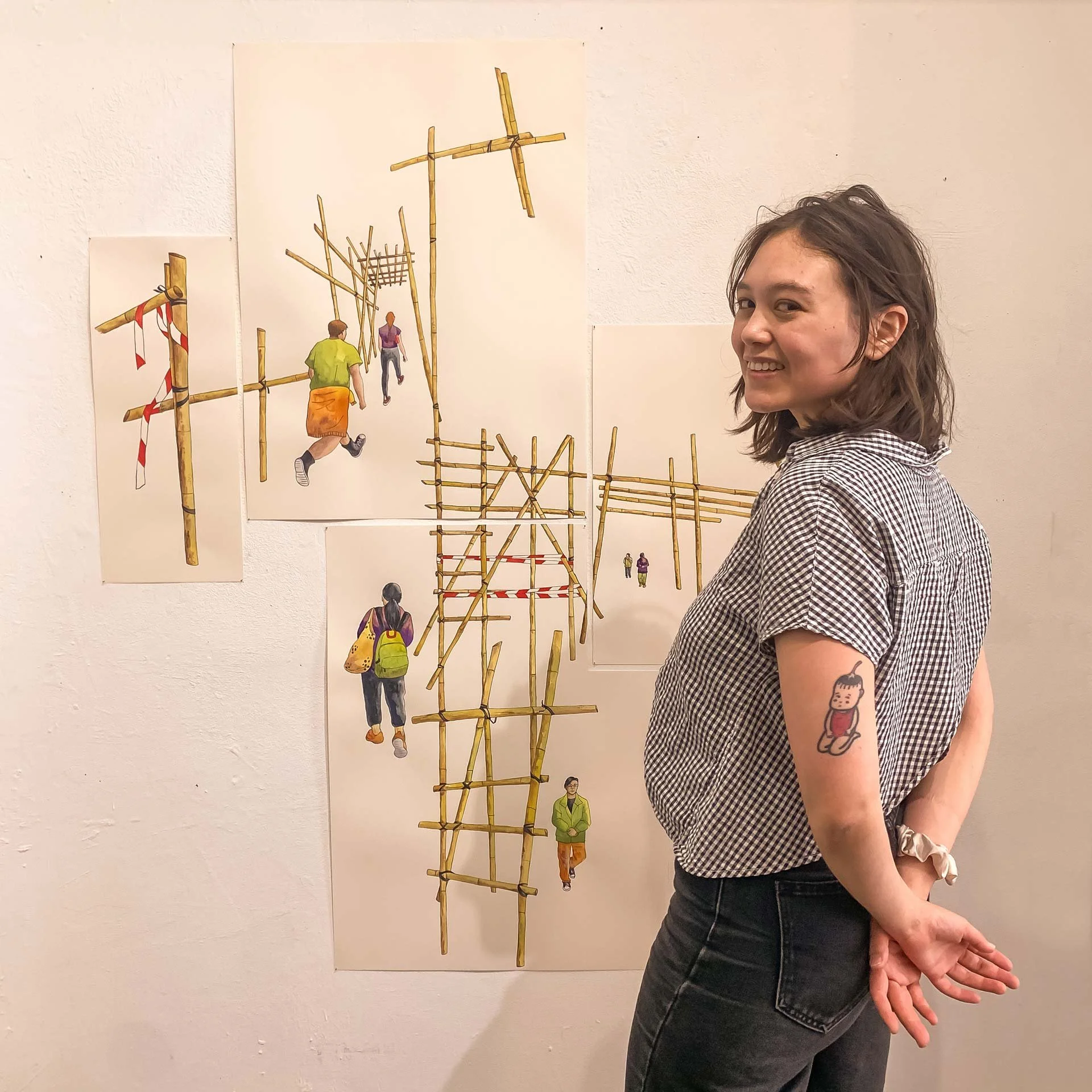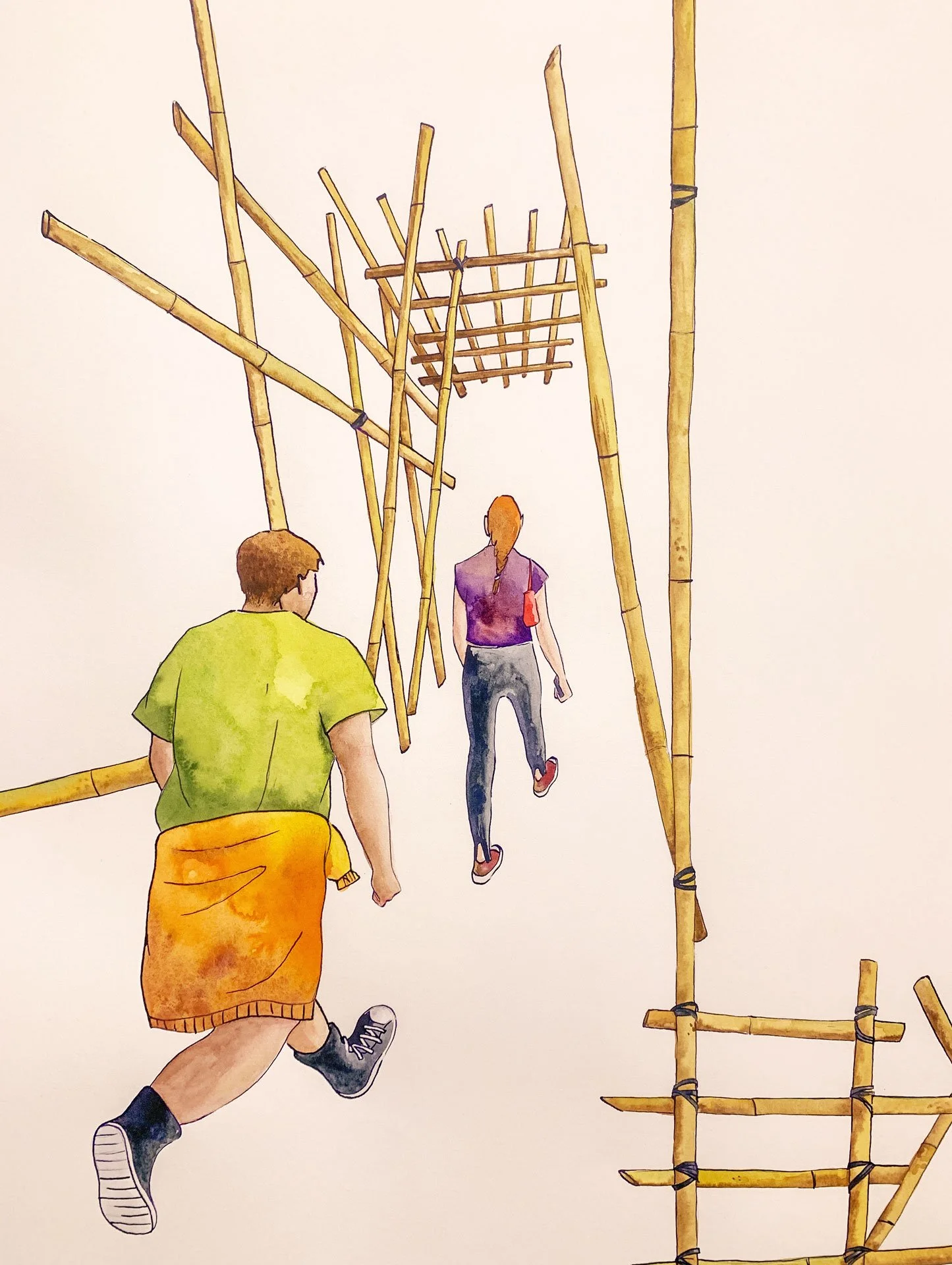“Bamboo Dreams”, May 2025, approx. 120 x 148 cm, watercolour, acrylic ink, colour pencil on paper.
What and Why
Bamboo scaffolding, used in Hong Kong building construction for multiple centuries, will soon be phased out. “Bamboo Dreams” is an homage to this cultural artefact in Hong Kong’s high-rise cityscape, and plays with the emotive distortion of architecture, as is often the case in our dreams.
I made this work to hold on to the memory of bamboo scaffolding — for a group exhibition with my art collective PULPXIX, titled “Rescaled”.
Bamboo Dreams, May 2025
What I learnt in this process:
Not working in isolation. I was about throw all of my social life out of the window for this project, but soon discovered that contact to my friends was precisely the thing that helped me move it forward. Thanks to my boyfriend I had access to a large scale scanner and light table (for enlarging and tracing), and thanks to another friend I had access to a plotter (for printing the draft). No way I would have gotten the art from draft to final at the same speed, with my regular A4 scanner/printer and A3 light table.
Leaving space for mystery. I left a lot of negative space in this work; not usual for my detail-obsessed self. But I’m learning that these open spaces leave the viewer room to breathe, to think. Not every space has to be filled, not every mark has to be completed, not every question answered — leave room for the viewer to answer these questions themselves. Side note: trying to keep all those white spaces pristine was still a challenge in itself!
Doing some colour studies (or as I like to call them, “painting rehearsals”) and deciding on a palette were helpful in feeling confident for the final painting.
Letting the work tell you where it wants to go. With every completed project I learn, and re-learn, that things don’t usually turn out 100% as you planned. Maybe the piece works better with a detail added or left out (usually the latter). It’s a huge lesson in staying present, I think, not “holding on to the past”, keeping an open mind, and going with the flow.
First idea and final sketch.
Presentation is half the work. Now that I’ve been in the group exhibition game for a while, I know that there is so much you can bring out of an artwork, beyond framing and hanging and calling it a day — an afterthought. Presentation is integral to the work itself, just as important, if not more. All of this takes time, a steady hand, focus. I think I spent about 2.5 hours mounting my piece to the wall, making sure it was centred and the gaps in between were even. I even made a last minute change, cutting out part of one of the panels, so that the whole looked more balanced.
Two out of my references photos! Many of these images became part of the final painting, as I traced directly over them. However, I still needed to adjust for scale/size — imagination required! I also found it helpful to study a piece of bamboo from real life, to get all the colour and texture nuances in the painting.
Don’t make things harder than they need to be. Having said all of the above… I think there is so much internal holding on to unnecessary narratives that make us do things in more complicated ways than they need to be. For me, this internal narrative is that I need to prove that I am the perfect draftswoman who doesn’t need visual references and aids. In this process, I tried to let of of that: I did not reference everything from life, I collaged and traced (my own) photos for visual material. Not everything is about “proving” yourself. Just get from A to B.
Draft to final… I do not have a photo of this anymore, but just imagine lots of little panels stuck together, scanned and enlarged, printed on one big piece of paper, then traced over and painted!
Have you had any AHA-moments in your creative process lately? No matter if it’s on a mental, practical or technical level… feel free to share in the comments below!
And… I’m curious about what kind of insights you would like to know from my creative process, whether its more mindset, or time management or technique… again, let me know in the comments below!



















